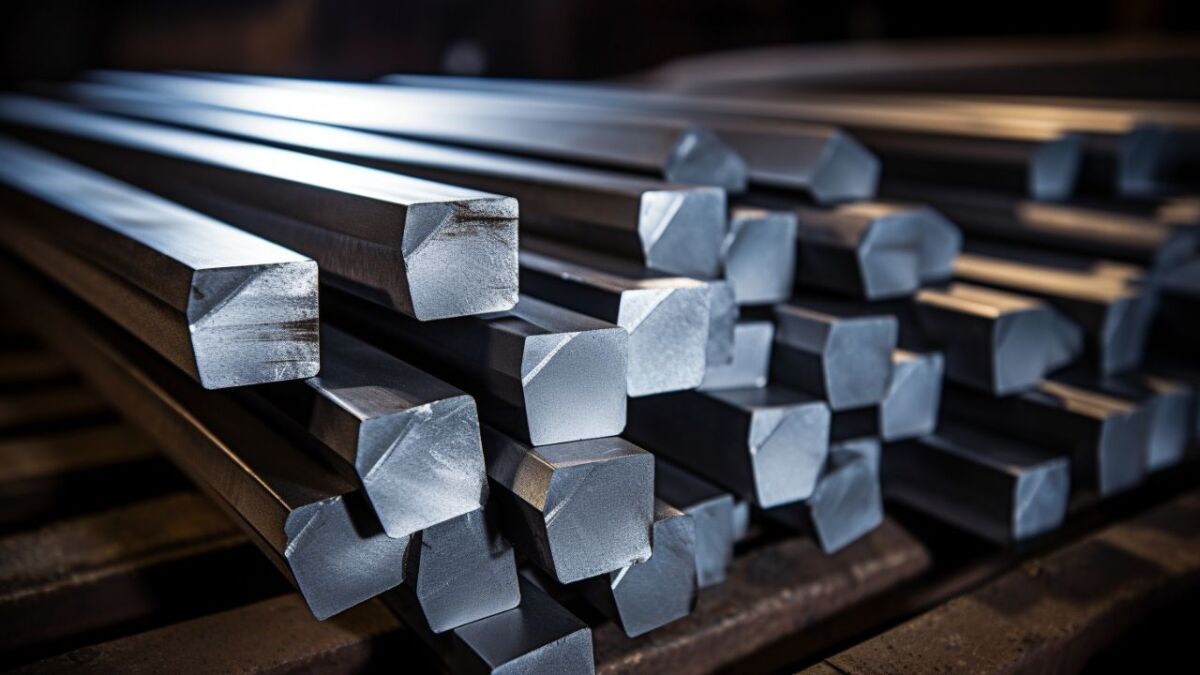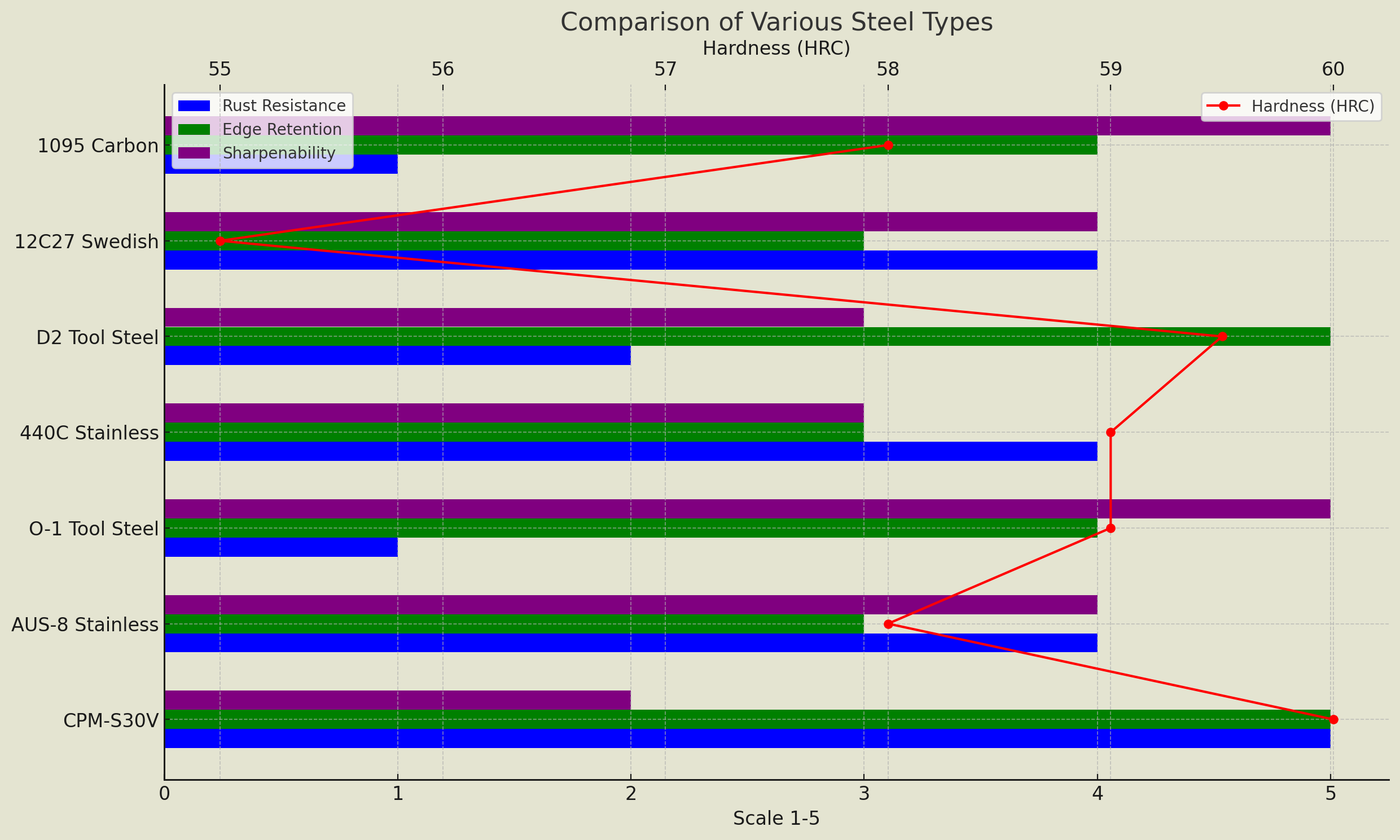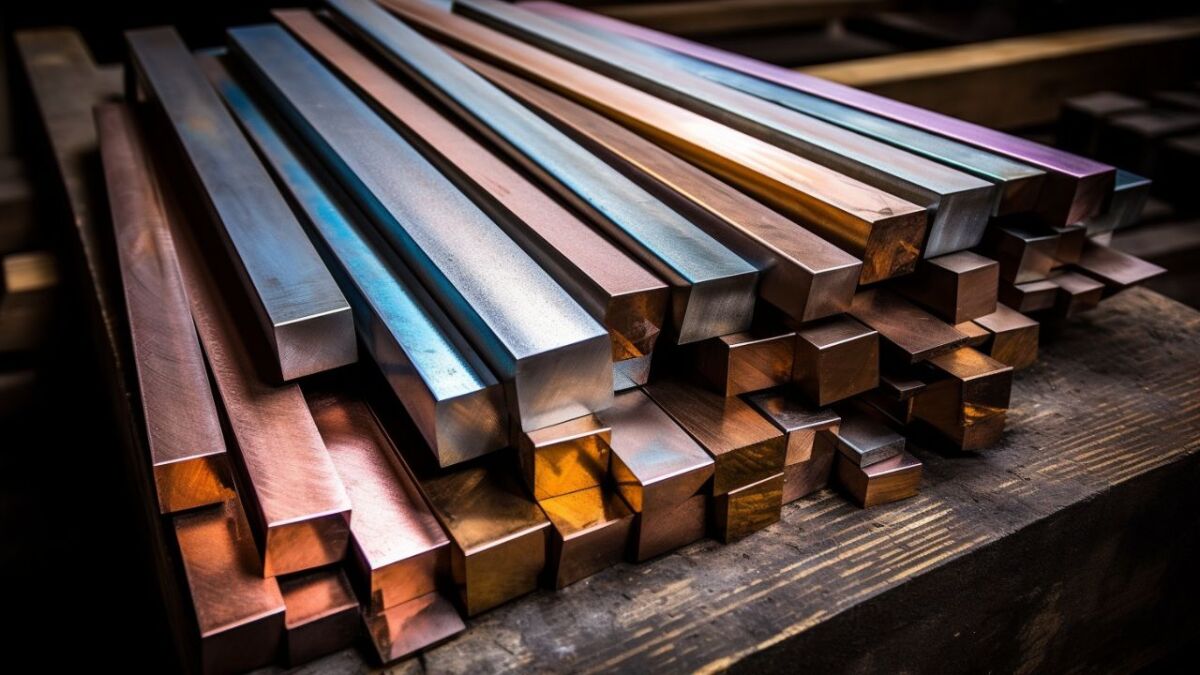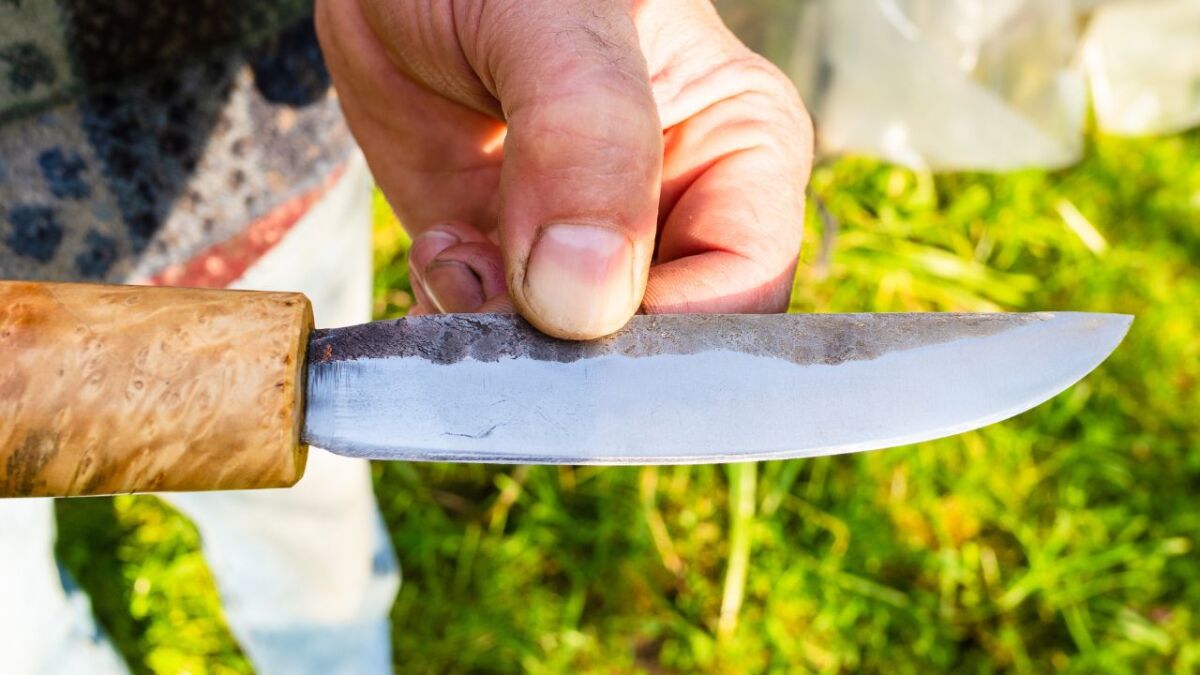Which steel is ideal for bushcraft knives? - 7 popular types of steel introduced
How to find the right steel for your Bushcraft knife - A practical guide that takes your Bushcraft skills to the next level.


From Martin Gebhardt. Check out my “About me” page.
👉 The key facts from this guide
- Generally: Learn which steel is best for your bushcraft knife.
- 1095 carbon steel: Hard and tough, but susceptible to rust.
- 12C27 Swedish steel: Good for outdoor, but not as hard.
- D2 tool steel: Very hard, but not completely rust-proof.
- 440C stainless steel: Rust-resistant, but less hard.
- O-1 tool steel: Hard and tough, but susceptible to rust.
- CPM-S30V: Top in hardness and rust resistance.
When it comes to Bushcrafting, a knife is an essential tool.
It is not only used for cutting and carving, but also for making fire, setting up tents, and many other tasks.
When choosing a bushcraft knife, there are several factors to consider, but one of the most important is the steel from which the blade is made.
In this article, we will delve into the question: Which steel is best suited for bushcraft knives?
Which steel for bushcraft knives?
The choice of the right steel for a bushcraft knife is crucial, as the blade does the majority of the work.
There are different types of steel to select from, but some are better suited for bushcraft knives than others.
Next, I will talk about HRC. HRC stands for Rockwell scale.
The Rockwell scale determines the hardness of metals and alloys by measuring the depth of penetration of a diamond cone. The lower the penetration depth, the higher the hardness indicated in HRC.
If you want to read more about the hardness of knives, then follow this link: What hardness should a knife have? - HRC explained simply
Here is a brief overview of the most popular steels for bushcraft knives:
| Steel Type | Hardness (HRC) | Advantages | Disadvantages | Special Features | Rust Resistance (Scale 1-5) | Edge Retention (Scale 1-5) | Sharpenability (Scale 1-5) |
|---|---|---|---|---|---|---|---|
| 1095 Carbon Steel | 57-59 | High hardness and toughness | Prone to rust | Easy to sharpen | 1 | 4 | 5 |
| 12C27 Swedish Stainless Steel | 54-56 | Good edge retention, corrosion resistance | Not as hard | Also known as Sandvik 12C27 or Sweden Steel | 4 | 3 | 4 |
| D2 Tool Steel | 58-61 | High hardness and wear resistance | Not stainless | Excellent edge retention | 2 | 5 | 3 |
| 440C Stainless Steel | 58-60 | Resistant to wear and rust | Not as hard as others | Also known as X105CrMoV17, 1.4125, or Böhler N695 | 4 | 3 | 3 |
| O-1 Tool Steel | 57-61 | High hardness and toughness | Not stainless | Easy to sharpen | 1 | 4 | 5 |
| AUS-8 Stainless Steel | 57-59 | Good corrosion resistance and edge retention | - | Also known as 7Cr17MoV | 4 | 3 | 4 |
| CPM-S30V | 59-61 | Excellent edge retention and corrosion resistance | - | Popular in the bushcraft community | 5 | 5 | 2 |
Hardness (HRC): Rockwell hardness of the steel.
Rust resistance (scale 1-5): 1 is the least rust resistant, 5 is the most.
Edge retention (scale 1-5): 1 is the least edge-retaining, 5 is the most.
Resharpenability (scale 1-5): 1 is the hardest to resharpen, 5 is the easiest.
Check out the graphic below. It shows how the different steel grades perform in four categories.
- Blue: rust resistance. The higher the bar, the better.
- Green: edge retention. A high bar means the knife stays sharp longer.
- Purple: Resharpenability. A high bar means the knife is easy to sharpen.
- Red dots: Hardness in HRC. A high point means more hardness.

Now let's move on to the most popular types of steel for bushcraft knives:
1. 1095 Carbon Steel
1095 carbon steel is a popular steel for bushcraft knives due to its high hardness (57-59 HRC) and toughness.
He is susceptible to rust, but with the right care and regular oiling, this can be minimized.
Knives made of 1095 carbon steel are easy to sharpen and retain their sharpness well.
Example knife:

Amazon
Offer
Data updated 2 hours ago
- Experience the toughness of the field tested ESEE 4P, a fixed blade knife designed for real survival scenarios. Made from 1095 carbon steel, it’s a reliable partner in the harshest conditions, making it a top choice for a survival knife.
- With an overall length of 9” (22.86cm) and a cutting-edge length of 4” (10.14cm), the ESEE 4P is a reliable choice for outdoor adventures.
- Durability – Handle material is comprised of Gray Linen Micarta
- Whether you’re hunting or camping, the ESEE 4P is the perfect companion. Weighing in at approximately 8.0 oz, the ESEE 4P is lightweight enough for any endeavor.
- The Drop Point blade type allows for extra control when cutting or carving. Made in the USA.
$115.99
List Price: $140.00
2. 12C27 Swedish Steel (Sandvik)
The stainless 12C27 steel is ideal for outdoor and hunting knives. Its composition ensures good edge retention and corrosion resistance.
With proper heat treatment, it reaches 54-56 HRC. 12C27 does not tend to chip or break during sharpening and is also easy to sharpen for beginners. Diamond or ceramic stones are recommended.
12C27 is also known as Sandvic 12C27 or Swedish steel. Its properties vary depending on the hardening process. It is used by many knife manufacturers such as Morakniv, EKA, or for Laguiole knives.
The advantages are suitability for outdoor knives, easy sharpenability, and good corrosion resistance with sufficient hardness.
Example knife:
no price can be determined (B086TZMQZ8)
View Product3. D2 Tool Steel
D2 tool steel is a high-quality steel known for its high hardness (58-61 HRC) and wear resistance.
He is ideal for use with robust bushcraft knives as he offers excellent edge retention.
D2 steel, however, is not stainless, so a knife made from this steel requires regular maintenance to prevent rust formation.
Example knife:

Amazon
Offer
Data updated one hour ago
- Versatile and Sturdy: Full flat grind combined with a PVD coating, high-quality D2 steel drop point blade design offer excellent slicing, piercing capabilities and corrosion resistance, making it an ideal fixed blade survival knife with sheath.
- Essential Camping Knife: The strong (0.18 inch) thick spine is better to withstand stress on the blade when batoning. Hunting knife with holster are perfect for camping, hunting, fishing and survival adventure trips, guaranteeing excellent performance and reliability in any situation.
- Comfortable and Ergonomic Design: Lightweight brown micarta handle offers a comfortable and secure grip, ensuring precise control and reducing the risk of slippage during use.
- Secure and Convenient Carry: The included kydex sheath allows for both vertical and horizontal carry knife, providing easy access to your knife while on the go. It's a comprehensive survival tool that can be easily to be your belt knife. The survival knife with fire starter will help you start a fire in all weather conditions.
- Designed for Hunters and Outdoor Enthusiasts: With its rugged design and tactical features, this full tang bushcraft knife is ideal for hunting, camping, and other outdoor activities. It's a must-have tool for every adventurer.
$51.99
List Price: $59.99
4. 440C Stainless Steel
This steel is very resistant to wear and rust and retains its sharpness well. However, it is not as hard as other steel.
The material 440C is a great steel for knives. It is very strong and can withstand a lot. It is also known as X105CrMoV17, 1.4125 or Böhler N695.
This steel can become very hard, from 58 to 60 HRC. It does not rust quickly and can be polished well. This cold work steel is often used for knives because it has such good properties.
Example knife:
Matching this, I have a guide: What is better? D2 steel or 440C steel? - a detailed comparison
5. O-1 Tool Steel
O-1 tool steel is a versatile steel known for its high hardness and toughness. It is easy to sharpen and retains its sharpness well (57-61 HRC).
O1 steel, however, is not stainless, so a knife made from this steel requires regular maintenance to prevent rust formation.
6. AUS-8 Stainless Steel
AUS-8 stainless steel is an affordable steel known for its good corrosion resistance and edge retention. It is also known as 7Cr17MoV and has a hardness of 57-59 HRC.
He is easy to sharpen and retains his sharpness well. AUS-8 steel is a popular choice for affordable bushcraft knives.
7. CPM-S30V
CPM-S30V is a high-quality stainless steel known for its excellent edge retention and corrosion resistance. Its corrosion resistance is equal to or better than that of 440C.
He is very popular in the bushcraft community with a hardness of 59 to 61 HRC, as he offers a good balance between hardness and toughness. Knives made of CPM-S30V steel retain their sharpness even with intense use for a long time.
Example knife:
- Ready For Anything: The Manix 2 is an extremely capable full-sized folder that is known for it's strength and performance. Its broad blade provides exceptional cutting power, while its textured index finger choil and thumb ramp allow a forward grip.
- A Secure Grip: It's scaled G-10 handle has a unique non-slip checked texture. This handle provides a special kind of comfort, creating a reliable, long-term carry.
- Dependable: If you are looking for control and precision, look no more. This knife features our PlainEdge grind which is known for creating a smooth and exact cut.
- Low Friction: This knife features a blade ground with flat bevels that extend from the spine all the way to the cutting edge. This grind reduces drag during cutting and decreases overall weight.
- High-Strength Lock: The Ball Bearing Lock features a patented compressive lock that wedges a ball bearing between a fixed anvil and the blade tang. The mechanism also serves as a detent to hold the blade in the closed position.
no price can be determined (B002ECY7XI)
View ProductWhich steel is the best?
The question of the best steel for bushcraft knives cannot be answered in a general way, as it depends on the individual needs and preferences of the user.
Overall, the choice of the ideal steel for a bushcraft knife depends on various factors such as the intended use, budget, and personal preferences.
Every steel has its advantages and disadvantages that must be considered.
Some users prefer stainless steel for lower maintenance, while others prefer the high sharpness and toughness of carbon steel.
It is also important to note that the blade is only one part of the entire knife. The steel of the blade should harmonize well with the handle material and construction of the knife to ensure an optimal user experience.

Also read
What are the common knife grinds for outdoor knives? (How to choose the right outdoor knife) – Learn everything about the most important knife grinds for your outdoor knife. This way, you will find the optimal grind for each activity such as carving.
Frequently Asked Questions (FAQs)
Which steel is rust-free?
CPM-S30V and AUS-8 are your friends if you don't like rust. These steels are great for bushcraft knives. They are strong and stay clean for a long time.
Which steel is the hardest?
D2 tool steel is like the Superman of steels. It is hard and can withstand a lot. If you want a knife that will truly last, this is your choice.
Which steel is the easiest to sharpen?
1095 carbon steel and O1 tool steel are easy to sharpen. You don't need much time to get them sharp again. That's great if you're often in the woods and want to quickly get your knife back in shape.
Which steel retains its sharpness the best?
CPM-S30V and D2 tool steel stay sharp for a long time. You can cut a lot, and they will still stay sharp. This is great if you don't always have time to sharpen them.
Which steel is best suited for beginners?
AUS-8 stainless steel is great for beginners. It is not expensive and still good. It does not rust quickly and stays sharp for a while. Ideal if you are just starting out.
How to care for a carbon steel knife to prevent rust formation?
Your carbon steel knife needs oil and dryness. Oil it often and keep it dry. After using it, clean it and dry it well. This way it will stay beautiful and won't rust for a long time.

The Art of Steel Selection
When choosing a bushcraft knife, the blade steel is an important factor that must be considered.
There are different types of steel to decide from, ranging from stainless steel to carbon steel.
Every steel has its advantages and disadvantages, so it is essential to consider individual needs and preferences.
CPM-S30V, 1095 carbon steel, D2 tool steel, O1 tool steel, and AUS-8 stainless steel are just a few of the most popular steels for bushcraft knives.
Each of them offers unique characteristics and benefits. Therefore, it is advisable to try out different steels and find out which one best suits your needs.
Regardless of the chosen steel, it is important to regularly maintain the knife to preserve its performance and lifespan.
The fact is: With the right care and maintenance, a bushcraft knife made from any steel can be a loyal companion in the wilderness.
And if you're still looking for a good knife, take a look at my guides: The best bushcraft knife - your ultimate buying guide or The 8 best bushcraft knives with fire steel.


Author of the guide
Martin Gebhardt
Hey, I'm Martin. On my blog, you will learn the basics and numerous details about living in the wild. I think survival, bushcraft and the good life in nature are the keys to happiness. Find me here on Instagram or on YouTube. You can find more about my mission on the About Me page.
Since this is a gear guide, here ...
🤝8 reasons to trust my recommendation
-
Practical Experience: I have tested most of the products I recommend under extreme conditions myself.
-
Independence: As a wilderness mentor, I am not tied to any specific brands - this means my recommendations are unbiased.
-
Expertise: My many years of experience allow me to understand the intricacies and details of various products that a layperson might overlook.
-
Target group understanding: I understand the needs and challenges of outdoor enthusiasts, from beginners to seasoned experts.
-
Quality focus: I attach great importance to quality and longevity. These are characteristics that are crucial in the wild.
-
Clear communication: I try to explain the pros and cons of each product clearly and understandably so that you can make an informed decision.
-
Currentness: I always keep my guides up to date and adapt them to new findings or products.
-
Community Feedback: I work in wilderness schools, teach courses myself, attend courses and am active in various outdoor and survival communities and therefore integrate the feedback and experiences of others into my recommendations.
So when I introduce the best survival knives or flashlights, you can be sure that every recommendation is based on solid experience and extensive knowledge.
Was this guide helpful?
14 people found this guide helpful.
5.00 out of 5 points (14 Ratings)
Comments (0)
This post may contain affiliate links. So if you click on the links and make a purchase, I will receive a small commission at no additional cost to you. Click here, to learn more about it.






